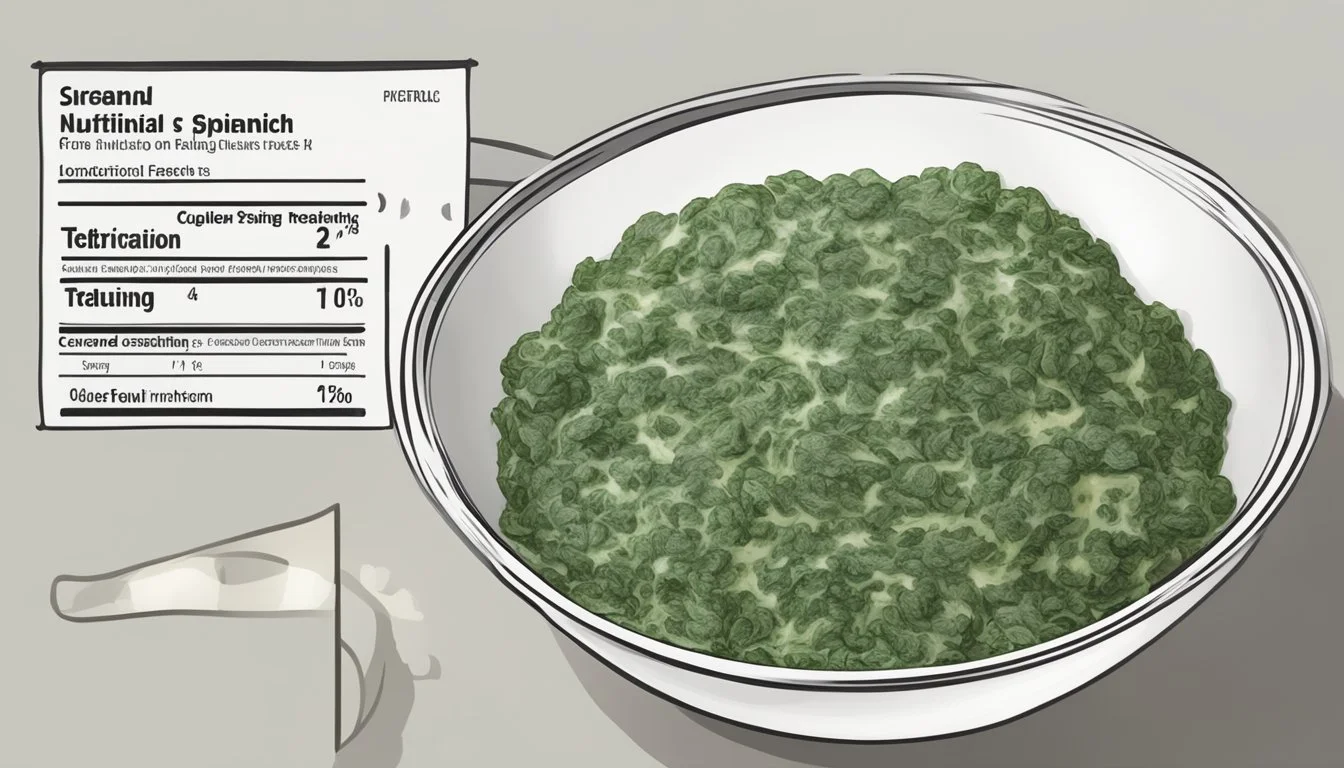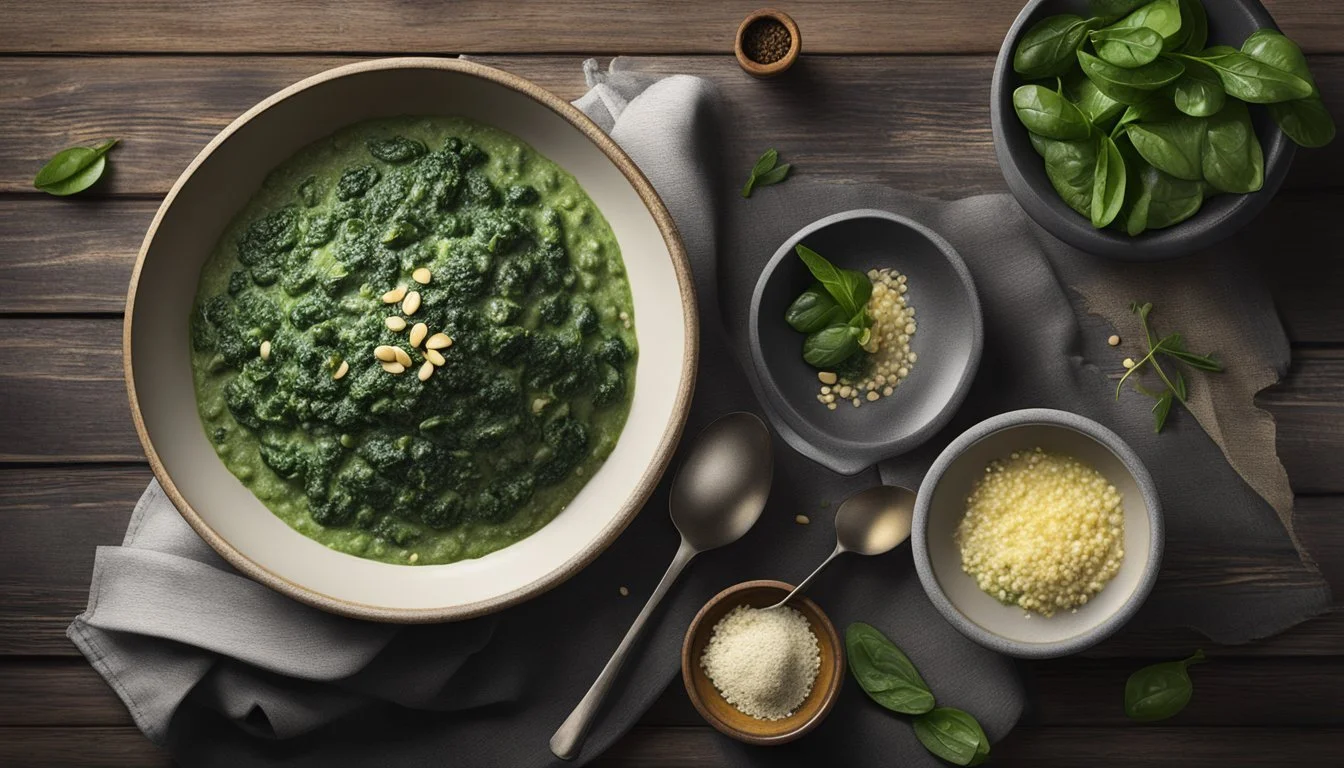How to Reheat Gluten-Free Creamed Spinach
Best Methods and Tips
Reheating gluten-free creamed spinach can be simple and straightforward, ensuring you retain its rich, creamy texture. To achieve the best results, remove the creamed spinach from the fridge and let it sit at room temperature for 10-15 minutes before reheating. This reduces thermal shock and helps maintain a consistent texture throughout.
Using an oven to reheat provides an even heat distribution, helping to preserve the dish's flavor and nutritional value. Preheat the oven to 300°F (150°C), transfer the spinach to a shallow baking dish, and add 1-2 tablespoons of milk or a gluten-free alternative. Cover the dish tightly with foil and heat for 5-10 minutes, stirring halfway through.
For a quicker option, reheating on the stovetop or using a microwave can be effective. Place the spinach in a frying pan over low heat or in a microwave-safe dish, adding a bit of liquid if necessary. Both methods ensure a healthy and delicious gluten-free meal without compromising simplicity.
Understanding Gluten-Free Diets
A gluten-free diet eliminates foods containing gluten, a protein found in wheat, barley, and rye. This diet is essential for those with celiac disease or gluten sensitivities and provides various health and digestive benefits.
Importance of Gluten-Free Ingredients
It is critical for individuals with celiac disease to avoid gluten entirely, as even small amounts can cause severe health issues. Gluten-free ingredients ensure that meals are safe and nutritious for those with dietary restrictions.
Common gluten-free alternatives include almond flour, rice flour, and tapioca starch. These ingredients not only add variety but also maintain nutritional value. Always check labels for hidden gluten sources, such as sauces and processed foods.
For those following a low-carb lifestyle, gluten-free ingredients can align well. Many are naturally low in carbohydrates, making it easier to manage weight and blood sugar levels.
Benefits for Health and Digestion
A gluten-free diet can significantly improve digestion for those with gluten intolerance. Symptoms like bloating, gas, and diarrhea often diminish when gluten is removed. This leads to a more comfortable and regular digestive process.
In addition to digestive relief, there are several health benefits. A gluten-free diet can enhance nutrient absorption in individuals with celiac disease, who might otherwise suffer from deficiencies.
Because gluten-free foods often emphasize whole, unprocessed items, this diet promotes overall healthy eating habits. Incorporating a variety of gluten-free grains, vegetables, and lean proteins can lead to a balanced and nutritious diet.
Selecting Quality Ingredients
Choosing ingredients thoughtfully ensures the best flavor and texture for gluten-free creamed spinach. Freshness, type, and quality of spinach, cream, and cheese all play crucial roles.
Choosing the Right Spinach
Using either fresh spinach or frozen spinach can yield excellent results, though their preparation methods differ. Fresh spinach, when chosen, should have vibrant green leaves, free from yellowing or wilting. Roughly chop it after washing thoroughly to remove any dirt.
For frozen spinach, ensure it is of high quality, free of added salts or preservatives. Thaw and drain excess water thoroughly before use. Removing liquid is crucial to avoid a watery dish.
Types of Cream for a Rich Flavor
Selecting the right type of cream is essential for achieving the desired richness. Heavy cream or whipping cream contains higher fat content, contributing to a creamier texture. These options are preferred for their ability to blend smoothly with other ingredients.
For a lighter version, half-and-half can be an acceptable substitute, though it may yield a less decadent result. Ensure the cream used is gluten-free, as some processed varieties may contain additives that are not safe for those with celiac disease.
Best Cheese Varieties for Creamed Spinach
Cheese provides depth and flavor to creamed spinach. Parmesan cheese is a popular choice for its strong, umami-rich flavor and smooth melting qualities. Another excellent option is Gruyère or aged cheddar, both of which add a robust, nutty taste.
For those seeking a non-dairy alternative, nutritional yeast can replicate some of the cheesy flavors while keeping the dish plant-based. Choose cheese varieties that explicitly state they are gluten-free to avoid cross-contamination. Balancing various types of cheese can enhance both texture and taste.
Selecting the best quality ingredients ensures that each component of gluten-free creamed spinach contributes to a harmonious, flavorful dish.
Preparation Techniques
Reheating gluten-free creamed spinach involves several crucial steps to maintain its flavor and texture. Careful handling of ingredients and following precise techniques will ensure a delicious result.
Thawing and Draining Spinach
Start by thawing the spinach if using frozen varieties. Place the frozen spinach in the refrigerator overnight or use a microwave to defrost it. Once thawed, place the spinach in a colander to drain the excess water.
Press down with a spoon or your hands to remove as much moisture as possible. Excess water can cause the dish to become runny.
Ensuring the spinach is well-drained is key to achieving a creamy consistency in the final dish. Dry spinach will absorb the cream and seasonings better, enhancing the flavor.
Sautéing Garlic and Onions
Chop garlic cloves and onions finely. Use a mixture of butter and oil in a skillet to sauté them. The combination of butter and oil prevents burning and adds depth to the flavor.
Heat the skillet over medium heat and add the chopped garlic and onions. Sauté until they are soft and translucent. This process takes about 5-7 minutes.
The aroma of the sautéing garlic and onions will set the base for the creamed spinach. Cooking them until they are just right ensures that their flavors are fully released.
Combining Ingredients Properly
Once the garlic and onions are sautéed, gradually add the drained spinach to the skillet. Stir well to combine. Add your cream, milk, or a dairy substitute if you prefer a gluten-free option.
Cook on low heat, stirring constantly. This allows the spinach to absorb the creamy mixture fully. Ensure the ingredients are thoroughly combined to avoid any clumps.
Season with salt, pepper, and any additional spices that complement your taste. Consistent stirring and careful seasoning are essential for a velvety texture and balanced flavor.
Creating a Gluten-Free Roux
When making a gluten-free roux, choosing the correct gluten-free flour and achieving the right consistency is key.
Substitutes for Traditional Flour
Traditional flour can be replaced with various gluten-free flours. Gluten-free all-purpose flour blends are popular because they mix several flours, such as rice flour, tapioca starch, and potato starch. These blends often mimic the texture and behavior of regular flour in a roux.
Rice flour is another good choice, providing a similar thickness without the gluten. For those needing a dairy-free option, using oil instead of butter can be an excellent substitute, maintaining the same smooth consistency in the roux. Almond flour or coconut flour can be used too, but they can impart a different flavor, so careful consideration is necessary.
Achieving Desired Consistency
To achieve the desired consistency, start by melting butter or heating oil on medium-low heat in a saucepan. Whisk in the chosen gluten-free flour slowly to avoid lumps.
Continue whisking for 2-3 minutes until it starts to bubble but does not darken.
Using a 1:1 ratio (equal parts flour and butter/oil) generally works well. If a thicker roux is needed for a heartier cream sauce, allow it to cook a bit longer.
For a dairy-free cream sauce, substitute cream cheese with alternatives like coconut cream or almond milk, ensuring to maintain the gluten-free element.
Stirring constantly is essential to maintain a smooth, consistent roux without burning or clumping.
Mastering Seasoning and Spices
Seasoning and spicing are crucial for enhancing the flavors of gluten-free creamed spinach. Achieving the right balance of salt, pepper, nutmeg, and other spices ensures a well-rounded and delicious dish.
Balancing Salt and Pepper
Salt and pepper form the foundation of well-seasoned creamed spinach. Salt not only boosts the natural flavors of the spinach but also enhances the creamy texture. It’s essential to start with small amounts and adjust gradually to avoid over-salting.
Pepper adds a subtle heat and complexity. Freshly ground black pepper is preferred for its stronger flavor compared to pre-ground varieties. White pepper can be a good alternative if a milder spice level is desired.
A pinch of red pepper flakes can be added to introduce a mild, tangy heat, but this is optional based on preference.
Adding Depth with Nutmeg and Other Spices
Nutmeg is a classic addition to creamed spinach, providing a warm, slightly sweet undertone. Freshly grated nutmeg is recommended for a more pronounced flavor compared to pre-ground nutmeg. Start with a small amount, typically around 1/8 teaspoon, to avoid overpowering the dish.
Other spices, such as garlic powder or onion powder, can add depth without overshadowing the primary flavors. These should be used sparingly, with adjustments based on taste preferences.
Optional spices that can complement the dish include a small dash of cayenne pepper for heat or a pinch of paprika for a touch of smokiness.
Achieving a perfect seasoning balance requires tasting and adjusting throughout the reheating process, ensuring the spices meld seamlessly into the creamy spinach.
Cooking Gluten-Free Creamed Spinach
Cooking gluten-free creamed spinach requires the right utensils and precise cooking times to achieve perfection. Knowing what to use and how to control the heat will result in a delicious and creamy dish.
Using the Right Cooking Utensils
For cooking gluten-free creamed spinach, select a large skillet or a saucepan. A large skillet ensures the spinach wilts evenly and allows enough space for stirring and combining ingredients.
Start by spraying the skillet with cooking spray to prevent sticking. Use a medium size mixing bowl to combine ingredients like cream cheese and gouda cheese. A garlic press and a sharp knife will help with prepping ingredients like garlic and onions. A wooden spoon is ideal for stirring, as it won't scratch the pan.
Time and Temperature for Perfection
Heat the skillet on medium-low heat to melt butter and sauté garlic for 1-2 minutes until fragrant. Add spinach in batches, stirring until it wilts. For cream sauce, add gluten-free flour and whisk for 2-3 minutes. Slowly introduce milk or cream to avoid lumps. Simmer for 10-15 minutes until the sauce thickens.
Cooking times are crucial. Wilt the spinach in 5-7 minutes. Total cooking time for the entire dish should be about 20 minutes for optimal texture and flavor.
Use a food thermometer to ensure the dish reaches at least 165°F (74°C) to confirm it's thoroughly cooked and safe to eat. Stirring intermittently helps in even cooking and prevents burning or sticking at the bottom of the skillet.
Reheating Leftovers
Reheating gluten-free creamed spinach properly ensures that the dish maintains both its safety and its delicious taste. To achieve this, pay attention to food safety guidelines and use methods that preserve the creamy texture and rich flavors of the spinach.
Ensuring Food Safety
Maintaining food safety is crucial when reheating leftover creamed spinach. Start by storing the leftovers in the fridge immediately after cooling. Ensure the spinach is kept at or below 40°F (4°C) to prevent bacterial growth. When ready to reheat, remove the creamed spinach from the fridge and let it sit at room temperature for about 10-15 minutes to reduce thermal shock.
Use a microwave-safe bowl or shallow baking dish for reheating. The spinach should be heated to an internal temperature of at least 165°F (74°C). This temperature ensures any potential bacteria are eliminated. Avoid reheating the spinach more than once, as repeated heating and cooling increase the risk of foodborne illnesses.
Maintaining Flavor and Texture
Preserving the flavor and texture of gluten-free creamed spinach is essential for an enjoyable meal. To reheat in the oven, preheat it to 300°F (150°C). Transfer the spinach to a shallow baking dish, add 1-2 tablespoons of liquid (like milk or cream), and cover the dish with foil. Heat for 15-20 minutes, stirring halfway through to prevent drying.
For microwave reheating, place the spinach in a microwave-safe bowl and sprinkle a few drops of water or milk over it. Cover the bowl with a microwave-safe lid or plate to retain moisture. Heat the spinach in short intervals of 1-2 minutes, stirring in between until evenly heated.
These methods help in maintaining the dish’s creamy consistency and rich taste, making sure leftovers are just as delightful as the initial serving.
Nutritional Information
Gluten-free creamed spinach is a nutritious side dish that offers a variety of vitamins and minerals, along with a balanced calorie and macronutrient profile. Here, you'll find detailed information on its caloric content and essential nutrients.
Caloric and Macronutrient Breakdown
A typical serving of gluten-free creamed spinach contains about 150-200 calories. This can vary depending on the specific ingredients and portion size. Protein content is usually around 3-5 grams. The dish includes fat from cream or butter, providing around 10-15 grams per serving, with 6-8 grams of saturated fat.
Carbohydrates in gluten-free creamed spinach are largely from the spinach itself and any thickeners used. It generally contains 6-8 grams of total carbohydrates, including 2-3 grams of fiber, leading to a net carb count of 4-6 grams. Sodium levels can be around 300-400 milligrams, depending on how much salt and processed ingredients are used.
Vitamins and Mineral Content
Gluten-free creamed spinach is rich in several key vitamins and minerals. It provides a substantial amount of Vitamin A, with one serving delivering over 50% of the daily recommended value, essential for vision and immune function. Vitamin C content is moderate, giving about 15-20% of the daily requirement.
Calcium is another important nutrient found in this dish, with a serving offering approximately 15-20% of the daily value, beneficial for bone health. Iron content is beneficial too, providing about 10-15% of daily needs, supporting oxygen transport in the blood. Additionally, it contains potassium, about 10% of the daily value, which is vital for muscle function and heart health.
Serving Suggestions
Reheated gluten-free creamed spinach can be enjoyed in various ways, enhancing the dining experience when paired with complementary foods or incorporated into other dishes. Specific pairing suggestions and dish integration ideas provide versatile options for any meal.
Pairings with Proteins
Creamed spinach works beautifully as a side dish with different proteins. When paired with a succulent steak, the creamy texture of the spinach balances the richness of the meat. It also complements grilled chicken by adding a rich and creamy element to the lean protein.
For those who prefer pork, creamed spinach adds a smooth, flavorful contrast to roasted or grilled cuts. Pairing it with proteins not only boosts the meal's nutritional value but also enriches the flavor profile, making it perfect for any occasion.
Incorporating into Other Dishes
Creamed spinach can also be a versatile ingredient in various dishes. Consider incorporating it into casseroles for a creamy component that enhances the overall texture and taste. It can be mixed with mashed potatoes for a unique twist, or even used as a base for a spinach dip.
During holiday meals, creamed spinach can be an elegant addition to your table, either as a side dish or stuffed into chicken breasts for a gourmet entrée. Incorporating it into other dishes allows for creative ways to elevate its flavor and make it the star of your meal.
Alternative Variations
There are numerous ways to adapt creamed spinach to meet various dietary needs, ensuring everyone can enjoy this nutritious dish. These include dairy-free and vegan options as well as keto-friendly adaptations.
Dairy-Free and Vegan Options
For those following a vegan or dairy-free diet, substituting traditional ingredients is key. Instead of dairy butter, vegan butter or olive oil can be used. Cashew cream, made by blending soaked cashews with water until smooth, serves as a creamy substitute for dairy cream. Nutritional yeast adds a cheesy flavor without dairy. It's essential to sauté the onion and garlic in the vegan butter until fragrant before adding the cashew cream and ensuring it combines with the spinach thoroughly. This method retains the rich, creamy texture while being suitable for vegan and dairy-free diets.
Keto-Friendly Adaptations
For individuals following a keto diet, minimizing carbs is crucial. Using full-fat dairy products like heavy cream instead of milk ensures the dish remains low in carbohydrates. Spinach is already a keto-friendly vegetable due to its low-carb content. Cooking methods such as using a nonstick skillet over medium heat help maintain the nutritional integrity of the spinach. The addition of spices like nutmeg and pepper can enhance the flavor without adding carbs. This method sustains the dish's keto compatibility while still delivering a creamy, satisfying texture suitable for low-carb diets.
Presentation and Garnishing Tips
Presenting gluten-free creamed spinach in an appealing manner enhances its enjoyment. Garnishes can add both flavor and visual appeal, making the dish more inviting.
Enhancing Visual Appeal
To make creamed spinach visually appealing, consider the dish it's served in. A white, shallow baking dish provides a clean backdrop. Sprinkle shredded cheese such as mozzarella on top. This not only adds flavor but also a golden-brown finish when broiled lightly.
Moreover, use fresh ingredients for garnish. A few sprigs of parsley or a light dusting of paprika can add a pop of color. Arrange the spinach neatly and wipe any spills around the edges before serving.
Adding Final Touches
Final touches bring the dish together. Crumbled bacon adds a savory crunch, while toasted nuts such as almonds or pine nuts contribute texture.
Incorporating fresh herbs like dill or basil can enhance the flavor. These should be added just before serving to retain their vibrant appearance.
Always serve hot and consider a drizzle of extra virgin olive oil for a touch of elegance. For those who love cheese, a sprinkle of Parmesan can also elevate the dish.











